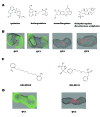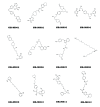Discovery of potent, novel, non-toxic anti-malarial compounds via quantum modelling, virtual screening and in vitro experimental validation
- PMID: 21933377
- PMCID: PMC3206494
- DOI: 10.1186/1475-2875-10-274
Discovery of potent, novel, non-toxic anti-malarial compounds via quantum modelling, virtual screening and in vitro experimental validation
Abstract
Background: Developing resistance towards existing anti-malarial therapies emphasize the urgent need for new therapeutic options. Additionally, many malaria drugs in use today have high toxicity and low therapeutic indices. Gradient Biomodeling, LLC has developed a quantum-model search technology that uses quantum similarity and does not depend explicitly on chemical structure, as molecules are rigorously described in fundamental quantum attributes related to individual pharmacological properties. Therapeutic activity, as well as toxicity and other essential properties can be analysed and optimized simultaneously, independently of one another. Such methodology is suitable for a search of novel, non-toxic, active anti-malarial compounds.
Methods: A set of innovative algorithms is used for the fast calculation and interpretation of electron-density attributes of molecular structures at the quantum level for rapid discovery of prospective pharmaceuticals. Potency and efficacy, as well as additional physicochemical, metabolic, pharmacokinetic, safety, permeability and other properties were characterized by the procedure. Once quantum models are developed and experimentally validated, the methodology provides a straightforward implementation for lead discovery, compound optimizzation and de novo molecular design.
Results: Starting with a diverse training set of 26 well-known anti-malarial agents combined with 1730 moderately active and inactive molecules, novel compounds that have strong anti-malarial activity, low cytotoxicity and structural dissimilarity from the training set were discovered and experimentally validated. Twelve compounds were identified in silico and tested in vitro; eight of them showed anti-malarial activity (IC50 ≤ 10 μM), with six being very effective (IC50 ≤ 1 μM), and four exhibiting low nanomolar potency. The most active compounds were also tested for mammalian cytotoxicity and found to be non-toxic, with a therapeutic index of more than 6,900 for the most active compound.
Conclusions: Gradient's metric modelling approach and electron-density molecular representations can be powerful tools in the discovery and design of novel anti-malarial compounds. Since the quantum models are agnostic of the particular biological target, the technology can account for different mechanisms of action and be used for de novo design of small molecules with activity against not only the asexual phase of the malaria parasite, but also against the liver stage of the parasite development, which may lead to true causal prophylaxis.
Figures




Similar articles
-
A novel approach for the discovery of chemically diverse anti-malarial compounds targeting the Plasmodium falciparum Coenzyme A synthesis pathway.Malar J. 2014 Aug 31;13:343. doi: 10.1186/1475-2875-13-343. Malar J. 2014. PMID: 25174342 Free PMC article.
-
Ligand-based virtual screening and in silico design of new antimalarial compounds using nonstochastic and stochastic total and atom-type quadratic maps.J Chem Inf Model. 2005 Jul-Aug;45(4):1082-100. doi: 10.1021/ci050085t. J Chem Inf Model. 2005. PMID: 16045304
-
An adaptable, fit-for-purpose screening approach with high-throughput capability to determine speed of action and stage specificity of anti-malarial compounds.Antimicrob Agents Chemother. 2024 Oct 8;68(10):e0074624. doi: 10.1128/aac.00746-24. Epub 2024 Sep 12. Antimicrob Agents Chemother. 2024. PMID: 39264187 Free PMC article.
-
Natural products as starting points for future anti-malarial therapies: going back to our roots?Malar J. 2011 Mar 15;10 Suppl 1(Suppl 1):S3. doi: 10.1186/1475-2875-10-S1-S3. Malar J. 2011. PMID: 21411014 Free PMC article. Review.
-
Recent progress in the development of anti-malarial quinolones.Malar J. 2014 Aug 30;13:339. doi: 10.1186/1475-2875-13-339. Malar J. 2014. PMID: 25176157 Free PMC article. Review.
Cited by
-
Antimalarial and cytotoxic activities of roots and fruits fractions of Astrodaucus persicus extract.Iran J Basic Med Sci. 2017 Dec;20(12):1318-1323. doi: 10.22038/IJBMS.2017.9554. Iran J Basic Med Sci. 2017. PMID: 29238466 Free PMC article.
-
Antimalarial activity of 80 % methanolic extract of Brassica nigra (L.) Koch. (Brassicaceae) seeds against Plasmodium berghei infection in mice.BMC Complement Altern Med. 2015 Oct 15;15:367. doi: 10.1186/s12906-015-0893-z. BMC Complement Altern Med. 2015. PMID: 26471058 Free PMC article.
-
Discovery of Novel Liver-Stage Antimalarials through Quantum Similarity.PLoS One. 2015 May 7;10(5):e0125593. doi: 10.1371/journal.pone.0125593. eCollection 2015. PLoS One. 2015. PMID: 25951139 Free PMC article.
-
Antimalarial Properties of Aqueous Crude Extracts of Gynostemma pentaphyllum and Moringa oleifera Leaves in Combination with Artesunate in Plasmodium berghei-Infected Mice.J Trop Med. 2016;2016:8031392. doi: 10.1155/2016/8031392. Epub 2016 Oct 31. J Trop Med. 2016. PMID: 27872647 Free PMC article.
-
Discovery of potent, novel Nrf2 inducers via quantum modeling, virtual screening, and in vitro experimental validation.Chem Biol Drug Des. 2012 Dec;80(6):810-20. doi: 10.1111/cbdd.12040. Epub 2012 Oct 9. Chem Biol Drug Des. 2012. PMID: 22925725 Free PMC article.
References
Publication types
MeSH terms
Substances
LinkOut - more resources
Full Text Sources

